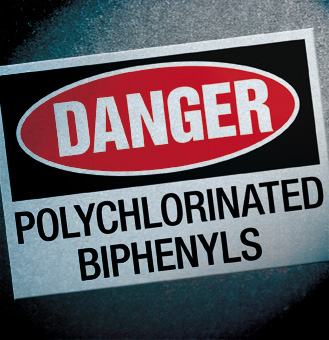
While the importation of Polychlorinated Biphenyls is banned in Australia, an electrician can still come into contact with the hazardous material on a daily basis.
Polychlorinated biphenyls (PCBs) may be a bit difficult to pronounce, but don’t let that stop you from reading the rest of this article. All electricians should be aware of the possibility that PCBs could be lurking in older electrical equipment.
PCBs were used extensively as fluids in electrical equipment such as transformers, capacitors and fluorescent light ballasts from the 1950s through to the 1970s.
The reasoning behind this was that PCBs were considered to be a stable chemical that could resist change over time, wide temperature variances and the influence of acids and alkalis. In addition to use in electrical equipment, the material was also used in pesticides and carbonless copier paper, while small PCB-filled capacitors were fitted to electric motors and welders.
The good news is that the importation of PCBs was banned in Australia in 1976 – but this doesn’t mean that an electrician is in the clear yet. Just like the issue of asbestos, some equipment containing PCBs are still in use today.
Concerned? You should be.
There are three ways to come into contact with the hazardous material: it can be swallowed in contaminated food or drink; absorbed through the skin; or inhaled as vapour. PCBs are considered to be a serious health hazard to electricians because of its persistence in the environment and potential for chronic or delayed toxicity.
What’s more, many of the electricians who have been exposed to the chemical haven’t been given enough information about the dangers of this or correct procedures for the safe handling, transportation and disposal of PCBs.
However, there are health and safety services in Australia that have taken an active role in educating electricians about the dangers of working with the material. Workers Health Centre occupational hygienist Peggy Trompf says it’s important for electricians to at least be aware of the hazardous chemical, as it can be found in many different products in the industry.
“The major use of PCBs in the electrical industry has been as an insulating fluid inside transformers and capacitors. It can range in appearance from colourless, oily liquids to thicker and increasingly darker liquids, to yellow then black resins, depending on the chlorine content,” she says.
“You’ll find that the large transformers used by electrical supply industries and heavy industries may contain several thousand litres of PCBs, while small capacitors may only contain several millilitres.”
Peggy says that a broad range of health problems have been reported in people exposed to the chemical.
“These health effects increase with the amount of PCBs and length of exposure – absorption through the skin represents the major occupational health risk. It accumulates in the body with repeated exposure and is stored in fat tissue and body organs including the liver, kidney, lungs and brain,” she explains.
“The most commonly-observed symptom in people exposed to high levels of PCBs is chloracne, a severe and persistent acne-like rash. Other symptoms include liver damage, respiratory disorders, thyroid gland disorders, muscle and joint pain, headaches, loss of appetite, nausea, vomiting, abdominal pain and possibly cancer.”
She says the guide, Identification of PCB-containing capacitors published by the Australian and New Zealand Environment and Conservation Council (ANZECC), provides detailed lists of electrical equipment that is known to either contain or not contain the chemical.
“If you’re still unsure of whether a product contains the chemical, additional information can also be found on the product’s name plate, original purchase specification, tender and contract documents, test certificate and equipment manuals or by contacting the manufacturer.”
Peggy says that electricians are most likely to be exposed to PCBs when servicing and dismantling electrical appliances, transformers and capacitors. However, the chemical can also be found in hazardous waste sites, sewerage sludge and in soot from transformer fires.
“Illegally disposed materials, probably not labelled, containing PCBs and PCB waste may also be found at landfill sites where they may leak,” she says.
So, what can electricians do to make sure they don’t fall victim to PCB exposure?
Peggy insists that any electrical equipment which is known to contain PCBs but needs to remain in service should be identified with prominent labels. Also, care should be taken to avoid spillage or leakage of PCBs and all leaking capacitors must be replaced with non-PCB capacitors, with the work carried out by a licensed electrical worker.
“Where workers may come into direct contact with the chemical, such as when handling damaged capacitors, they should wear disposable gloves made of materials that are resistant to PCBs – do not use PVC or latex gloves,” she says.
“On top of this, wear disposable overalls and boots with chemical resistant properties. Eye protection is also essential.”
If working overhead (e.g. with light fixtures), then a full face shield should be worn. Scheduled PCB material and waste must be transported in accordance with the Australian Dangerous Goods (ADG) Code and any other legislative requirements.
“All workers involved in the transport of PCB wastes should be fully informed of the hazards and trained in the correct procedures required for the safe transport of these hazardous materials.”





